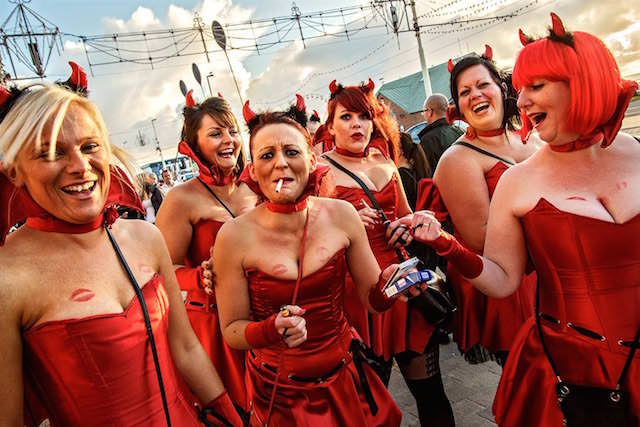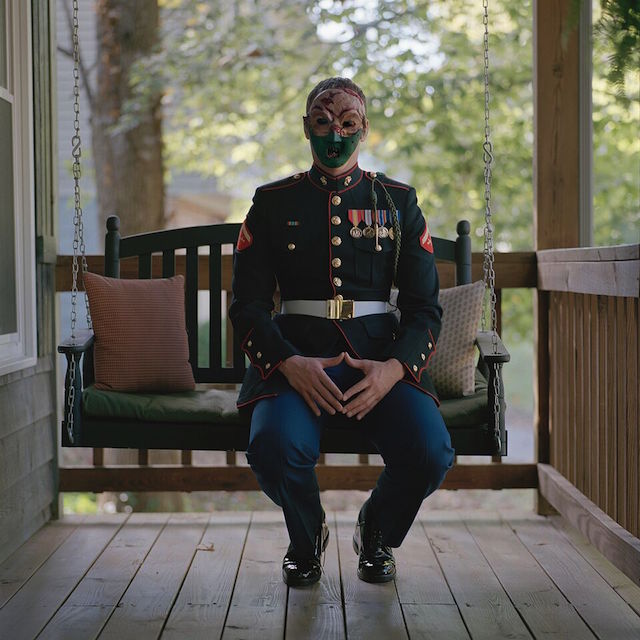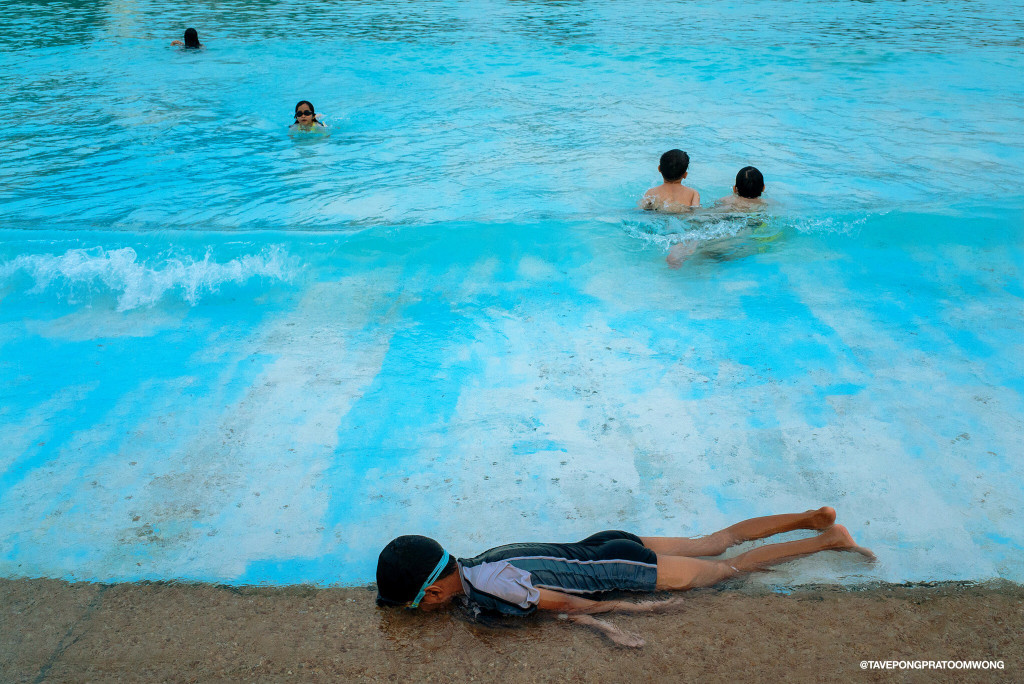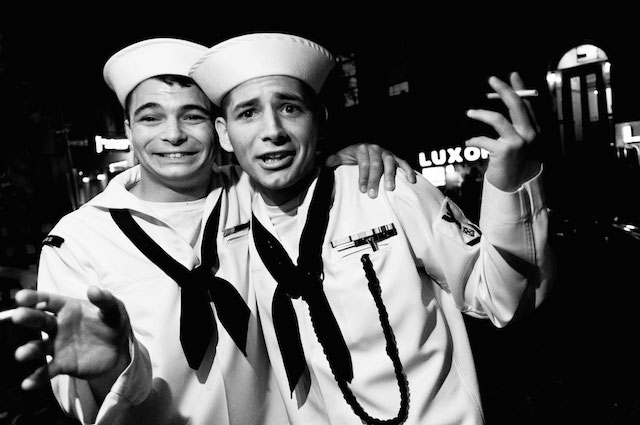

Dougie Wallace captures the Vegas-style shenanigans of Blackpool, England in his Photoville exhibit, “Stags Hens & Bunnies, A Blackpool Story.” Photo: Dougie Wallace
If you have somehow missed it over the last four years, New York’s largest annual photo exhibition is an impressive, immersive cross between a street museum, an art installation and day out in the sun, all in one.
“Photoville is that rare hybrid where you can come down to the park, grab a beer, walk your dog, and see important work from across the globe,” says co-founder Dave Shelley of the photo exhibition, which returns to Dumbo today along the edges of the East River in Brooklyn Bridge Park’s Pier 5.
He’s right on all counts. Photographs and video installations are exhibited in 65 repurposed shipping containers and on temporary walls, while panels and presentations are conducted in a beer garden. And it’s all free–except for the beer.
Shelley, who co-runs run the gallery and public art organization, United Photo Industries in Dumbo, introduced the idea of a pop-up photo exhibition at the 2011 Dumbo Arts Festival. Called Foto/Pods, the installation consisted of five containers, including a camera obscura. Regina Meyer, the president of Brooklyn Bridge Park, was so enthralled with the project that she offered them waterfront space for the following year, and the Photoville we know was born.
The event returns this year with renewed aplomb and an almost incomprehensible magnitude of work. “Photoville is a very fluid village,” says Shelley, “consisting of individual photographers and agencies. We curate the curators.” The likes of TIME Magazine, National Geographic, Getty Images, and the Magnum Foundation have all curated exhibits this year, as well as everyone’s favorite can’t-stop-won’t-stop photo sharing app, Instagram.
“We are now living in a world where information and images are being thrown at us every second of every day, and we are seeing more online than in the flesh,” adds Shelley when asked about how Instagram has altered the world of photography in recent years. “Platforms like Instagram give opportunities for photographers to get their work out to the public–social media gives us access to work we wouldn’t find anywhere else.”
Perhaps this heightened interest in documentary expression, thanks to the incredible, unavoidable fact that we can now capture and share images in real time, is the reason why Photoville hosted over 70,000 visitors last year, exhibiting a body of work that ventured into the most unexpected corners. This year, with stunning portraits of female Muslim romance authors living in northern Nigeria to images of the protests in Charleston, from examining the odd beauty of sphinx cats to showcasing the daily life of prisoners and guards at Guantánamo Bay, Photoville can show you the world, if you let it. Below, we’ve rounded up seven exhibits and events to see this weekend and next.

In “Blast Force Survivors,” Lynn Johnson photographed soldiers wearing masks that reflect the trauma they experience as a result of the injuries they suffered in Iraq and Afghanistan. Photo: Lynn Johnson
1. Lynn Johnson’s “Blast Force Survivors”
Sometimes called “the invisible injury,” blast force is one of the most significant medical issues that devastate soldiers after serving in places like Afghanistan or Iraq. It’s the absence of external injuries that belies the trauma that afflicts survivors, whether that trauma means a complete hotwiring of your personality or physical issues that come with the severing of nerve pathways. Lynn Johnson’s work centers around six blast force survivors who seek treatment at the National Intrepid Center of Excellence. As part of their treatment, soldiers make intricate masks of their psyches. Johnson’s severely emotive portraits document these blast force survivors at home in their daily lives, wearing their scars so that for the first time, they’re visible to everyone.

Daniel Berehulak won the Pulitzer prize for documenting the Ebola crisis last year in Sierra Leone, Guinea and Liberia, where this was taken. Photo: Daniel Berehulak
2. Daniel Berehulak’s “Scenes From The Ebola Crisis”
Whereas some photographers might think twice before heading off into the heart of the Ebola crisis, New York Times photographer Daniel Berehulak felt it was necessary to document the virus that was “affecting all of mankind.” His incredible efforts resulted in a Pulitzer Prize for capturing unimaginable scenes across Sierra Leone, Liberia, and Guinea.
3. Event: Print Swap
Think someone wants a piece of your stellar 35 mm shots from the time you hiked in Yosemite? You might be right. Print Swap is a free, RSVP event that invites photographers to bring in two to five of their own prints that they’d be willing to trade with other photographers. Mingling and feedback is highly encouraged.
4. Dougie Wallace’s “Stags, Hens & Bunnies, A Blackpool Story”
England’s town of Blackpool, something of a Las Vegas mixed with Coney Island and multiplied by fifty, has a lot to offer in terms of pure and utter debauchery. Dougie Wallace’s photographs are dripping with delightful seediness, from drunken middle-aged women draped in corsets and devil ears to bachelor parties gone bloody, everyone ending their nights with a steaming hot plate of junk food and a good amount of slurring.

EyEm’s interactive installation, “The Rise of Real Photography,” lets you contribute to a stream of photos in real time. Photo: EyEm
5. EyEm Presents The Rise of Real Photography
If a few jaunts around Photoville inspire you to foray into the curatorial arts, definitely stop by EyEm’s interactive installation. With live photos streaming in from all around the world, you’ll have the chance to contribute to and curate a depiction of moments as they’re happening in real time.

Kathryn Mussallem visited ports around the country as part of her series, “Hey Sailor! What’s New In Town.” Photo: Kathryn Mussallem
6. Kathryn Mussalem’s “Hey Sailor! What’s New In Town?”
Kathryn Mussalem says she “turned a lifetime fetish into an immersive documentary project.” We suppose we would too, if our fetishes involved stalking sailors. For four years, Mussalem traveled around the U.S. befriending sailors as they docked, documenting their time on land both at a distance and in more intimate settings, resulting in a humorous photo series that comes off as rather timeless. “Hey Sailor! What’s New In Town” is part of Photoville’s brand new Emergicubes series, which invites four photo professionals to nominate photographers to have their work featured.
7. The Photographers Playdate: What Color Is Your Aura?
You’ve already picked out your spirit animal—but how well do you know your aura? Stop by Aperture’s studio at the Activity Tent, where you’ll meet with an “aura consultant” to decide which colors of the spectrum best represent you, and then have your photo taken in front of your selected colors. You’ll go home with a portrait, and perhaps a wee bit of introspection.

